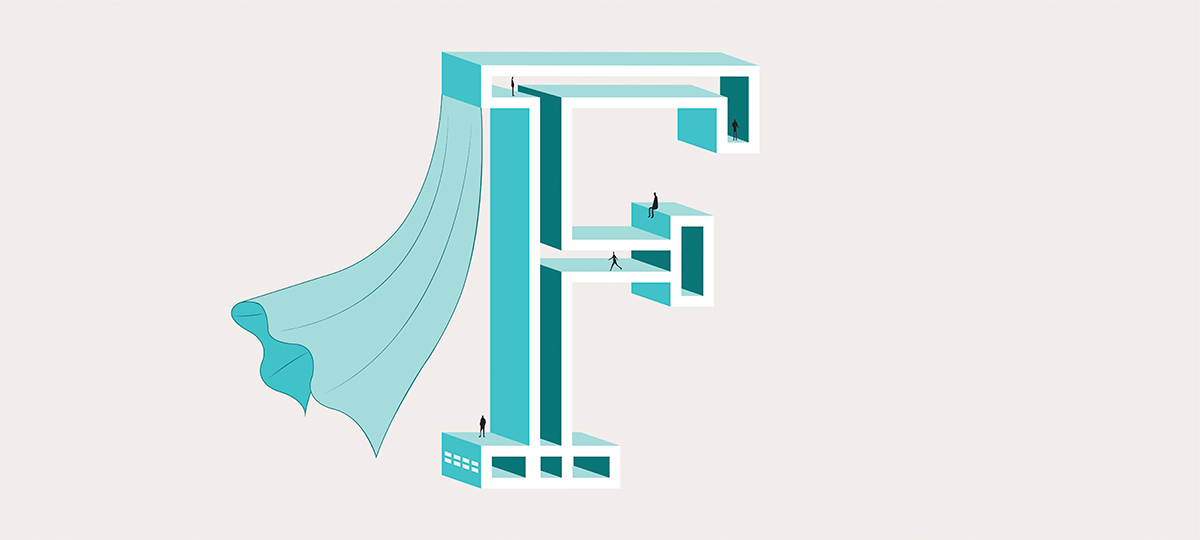
● ARCHITECT’S ALPHABET ●
F is for facade.
The facade represents the elevation of a building and is often designed according to a composition that contributes to give it its character and identity. It belongs as much to the building as to the street, the district, the city in which it is inserted.
A real link between the public space and the interior of the building, it crystallizes strong issues in the design of a building.
This wall between the public and private spheres, this two-sided envelope is reminiscent of the function of clothing that protects the body from the cold, the weather and the view. One speaks moreover of envelope, of external skin, of re-“clothing” of frontage and body of building. The facade, like a garment, has a back, a place, protects, covers, can be light and transparent or on the contrary heavy and opaque.
The register of the fabric is also pursued through the veil, which is very present in the architecture of the façade. We speak of curtain wall, concrete veil, veiled wall and some buildings are inaugurated by raising the veil.
Even more than clothing, the veil is the material of the in-between.
The Curtain Wall House in Tokyo, Japan is a representative achievement. The architect Shigeru Ban has reinterpreted, for himself, the traditional house literally through a fabric curtain on two floors. Quite a wink tinged with humor to Mies van der Rohe, inventor of the curtain wall.
More topical (work has begun and will continue until 2026), Rudy Ricciotti is covering the Musée des Tissus de Lyon with a spectacular mineral drape made up of a series of vertical brackets in UHPC (ultra high performance fiber concrete). Inside the building, the drape will be extended into a glass version and then into a textile version, with a highly technical fabric covering developed by a weaving industry company that inherited the Jacquard mechanism.
In Paris, Jean Nouvel plays with the theme of the veil and transparency with Fondation Cartier. He imagines a glass screen placed at the level of the sidewalk extending the perspective of the boulevard Raspail. A glass box façade? No, a real false façade and a real ice palace. This immense business card and communication medium metamorphoses according to the hours of the day and night. The building is not adjoined and is set back.
MVRDV reinvented the façade of magasin Hermès d’Amsterdam by replacing the traditional bricks with glass bricks. The original architectural style is preserved and magnified (and the items almost within reach!).
If the textile register is a source of inspiration, the language of the skin and epidermis is also a resource for architects. The skin, made up of several layers and cells, is in perpetual evolution. It reacts to its environment, it has goose bumps, it pales, it blushes, it tans, it sweats, it molts, it withers…
It inspires organic and sensory facades.
Mark Goulthrop’s experimental façade ” Aegis Hyposurface ” illustrates these lines of research. The surface, made of metal panels, moves in response to external movements, sounds or lights. The façade, like the human body, experiences the senses and perceptions associated with it. Thanks to the digital era, the building becomes a living and interactive entity.
The famous southern façade of The Institut du Monde Arabe, developed by Jean Nouvel, also meets the challenge of combining technicality and life. Its 240 mobile moucharabiehs were designed to open and close every hour, according to the variations of the light, thanks to an extremely sophisticated clockwork mechanism.
The plant facades currently being developed are also seeking this relationship with life, this sensual, tactile, fragrant proximity while being virtuous, even depolluting, and in connection with the city and nature.
You will have understood that the façade cannot be deaf to the urban, cultural and historical context in which it is inserted.
Whatever its form, its materials, its colors, it gives an atmosphere and especially tells a story.
This is the reason why we enjoy walking and traveling. In Bordeaux the blonde stone, in Toulouse the red brick, in Santorini the white plaster, in Lisbon the colored earthenware…
All this diversity is a real spectacle. Thank you to all the architects for working on such a richness.
